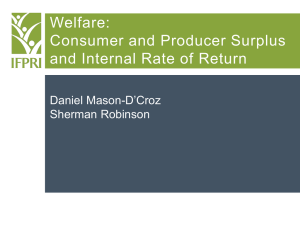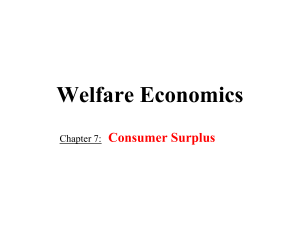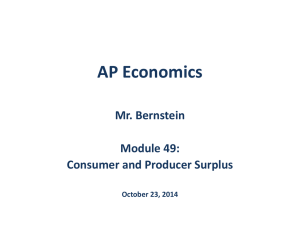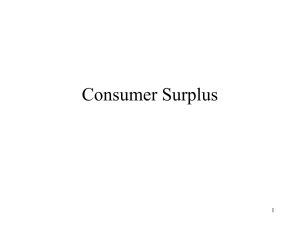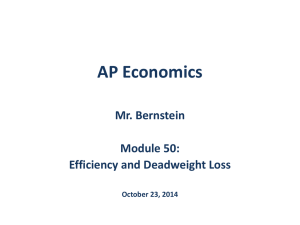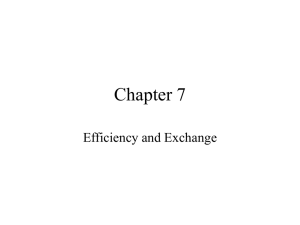Consumer`s and Producer`s Surpluses
advertisement
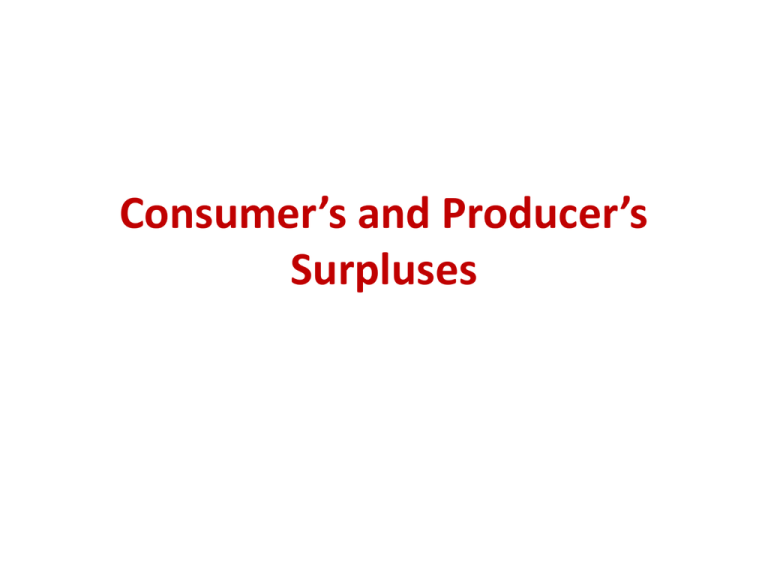
Consumer’s and Producer’s Surpluses Consumer Welfare • How much are consumers helped or harmed by shocks that affect the equilibrium price and quantity? • Shocks may come from new inventions that reduce firm costs, natural disasters, or government-imposed taxes, subsidies, or quotas. • You might think utility is a natural measure of consumer welfare. Utility is problematic because: • we rarely know a consumer’s utility function • utility doesn’t allow for easy comparisons across consumers • A better measure of consumer welfare is in terms of dollars. Consumer’s Surplus • Consumer’s surplus (CS) is the monetary difference between the maximum amount that a consumer is willing to pay for the quantity purchased and what the good actually costs. • Step function Marginal Value and Demand • Marginal Value: The maximum amount a consumer would be willing to pay to acquire an additional unit of a good – Marginal value curve and demand curve convey similar information • Application of equi-marginal principle – Buy the good as long as marginal value exceeds the price – The consumer is in equilibrium where marginal value equals the price • Total Value: The maximum amount a consumer would be willing to pay to acquire a given quantity of a good. A Numerical Example Quantity Price Willing to Pay Actual Payment Consumer Surplus 1 15 15 15 0 2 13 28 26 2 3 10 38 30 8 4 7 45 28 17 5 5 50 25 25 6 2 52 12 40 7 1 53 7 46 Marginal and Total Value The Consumer’s Surplus Consumer’s Surplus • Consumer’s surplus (CS) is the area under the inverse demand curve and above the market price up to the quantity purchased by the consumer. • Smooth inverse demand function Effect of a Price Change on Consumer’s Surplus • If the price of a good rises (e.g. £0.50 to £1), purchasers of that good lose consumer’s surplus (falls by A + B) • This is the amount of income we would have to give the consumer to offset the harm of an increase in price. Consumer’s Surplus: A Mathematical Application • Suppose that the demand function of a consumer is given by QD = 40 – 2P. If the market price P = 10, what is the consumer’s surplus? • Given the market price P = 10, a consumer’s quantity demanded QD = 40 – 2P = 40 – 2*10 = 20 • The consumer’s surplus is the area of the triangle between the price line and the inverse demand curve • The inverse demand function is P = 20 – (1/2)QD; the height of the triangle is the intercept of the inverse demand curve minus P, that is 20 – 10 = 10. CS = ½ (20*10) = 100 • If the market price falls to P = 5, how the consumer’s surplus would change? • Given the market price P = 5, a consumer’s quantity demanded QD = 40 – 2P = 40 – 2*5 = 30 • So the consumer’s surplus (the area of the triangle between the price line and the inverse demand curve) is CS = ½ (30*15) = 225 (because the height of the triangle is 20 – 5 = 15) • The change in consumer’s surplus, ∆CS = 225 – 100 = 125 Market Consumer Surplus • Market demand is the (horizontal) sum of individual demand curves; market CS is the sum of each individual consumer’s surplus. • CS losses following a price increase are larger: • the greater the initial revenue (p∙Q) spent on the good • the less elastic the demand curve at equilibrium Effect of a 10% Price Increase on Consumer Surplus • Revenue and Consumer Surplus in Billions of 2008 Dollars Deriving Demand Curves Graphically • Allowing the price of the good on the x-axis to fall, the budget constraint rotates out and shows how the optimal quantity of the x-axis good purchased increases. • This traces out points along the demand curve. Expenditure Function and Consumer Welfare • One measure of the harm to a consumer of a price increase is an increase in the consumer’s income needed to maintain the consumer’s utility. • Cannot use an uncompensated demand curve because utility varies along the curve • Can use compensated demand and the expenditure function because both hold utility constant • Recall that the minimal expenditure necessary to achieve a specific utility level and given a set of prices is: • Welfare change associated with price increase to p1*: Expenditure Function and Consumer Welfare • Which level of utility should be used in this calculation? • Two options: • Compensating variation is the amount of money we would have to give a consumer after a price increase to keep the consumer on their original indifference curve. • Equivalent variation is the amount of money we would have to take away from a consumer to harm the consumer as much as the price increase did. Compensating Variation and Equivalent Variation • Indifference curves can be used to determine compensating variation (CV) and equivalent variation (EV). Three Measures: CS, CV, and EV • Relationship between these measures for normal goods: • |CV| > |∆CS| > |EV| • For small changes in price, all three measures are very similar for most goods. Effects of Government Policies on Consumer Welfare • Government programs can alter consumers’ budget constraints and thereby affect consumer welfare. • Examples • Quota: reduces the number of units that a consumer buys • Subsidy: causes a rotation or parallel shift of the budget constraint • Welfare programs: may produce kinks in budget constraint Effects of Government Policies: Quotas • Quotas limit how much of a good consumers can purchase. • Quota of 12 units generates kink in budget line and removes shaded triangle region from individual’s choice set. • Because of this quota, the consumer’s equilibrium will be at the kink of the budget line, that is tangent to a lower indifference curve indicating lower level of utility. Effects of Government Policies: Welfare Programs • Welfare programs provide either in-kind transfers or a comparable amount of cash to low-income individuals. • Example: food stamps • $100 in food stamps (inkind) generates kinked budget line. • $100 cash transfer increases opportunity set further. Effects of Government Policies: Welfare Programs • Because food stamps can only be used on food, consumers are potentially worse off if they would find it optimal to consume less food and more other goods than allowed by the program. • Despite this, food stamps are used rather than comparable cash transfers in order to: • reduce expenditures on drugs and alcohol • encourage appropriate expenditure on food from a nutrition standpoint • maintain program support from taxpayers, who feel more comfortable providing in-kind rather than cash benefits Effects of Government Policies: Subsidies • Subsidies either lower prices or provide lump-sum payments to low-income individuals. • Example: child care subsidy • Reducing price of child care rotates budget line out • Unrestricted lump-sum payment (equal to taxpayers’ cost of the subsidy) shifts budget line out in a parallel fashion and increases opportunity set Challenge Question: Child-Care Subsidies • Background: • Government child-care subsidies are common throughout the world. • Rather than subsidizing the price of child care, the government could provide an unrestricted lump-sum payment that could be spent on child care or on all other goods, such as food and housing. • Questions: • For a given government expenditure, does a price subsidy or a lump-sum subsidy provide greater benefit to recipients? • Which option increases the demand for child-care services more? • Which one inflicts less cost on other consumers of child care? Challenge Solution • Child-care subsidy or lumpsum subsidy? • Original budget constraint is LO • If child-care subsidy, budget constraint is LPS . Family chooses e2 and utility is I2. • If lump-sum subsidy so that e2 is affordable, budget constraint is LLS . Family chooses e3 and utility is I3. • Taxpayer costs for the two programs are the same, but family is better off with the lump-sum subsidy. The Producer’s Surplus The Producer’s Surplus is defined as the dollar amount by which a firm benefits by producing its profit maximizing level of output. In other words, a Producer’s Surplus is the amount by which the producer’s revenue exceeds her variable production costs The Producer’s Surplus Producer Surplus • Producer surplus (PS) is the difference between the amount for which a good sells (market price) and the minimum amount necessary for sellers to be willing to produce it (marginal cost). • Step function Producer Surplus • Producer surplus (PS) is the area above the inverse supply curve and below the market price up to the quantity purchased by the consumer. • Smooth inverse supply function Producer’s Surplus: A Mathematical Application • Suppose that the supply function is given by QS = 2P. If the market price P = 10, what is the producer’s surplus? • Given the market price P = 10, a producer’s quantity supplied QS = 2P = 2*10 = 20 • So the producer’s surplus (the area of the triangle between the price line and the inverse supply curve) is • PS = ½ (20*10) = 100 • If the market price falls to P = 5, how the producer’s surplus would change? • Given the market price P = 5, a producer’s quantity supplied QS = 2P = 2*5 = 10 • So the producer’s surplus (the area of the triangle between the price line and the inverse supply curve) is • PS = ½ (5*10) = 25 • The change in producer’s surplus, ∆PS = 25 – 100 = – 75


